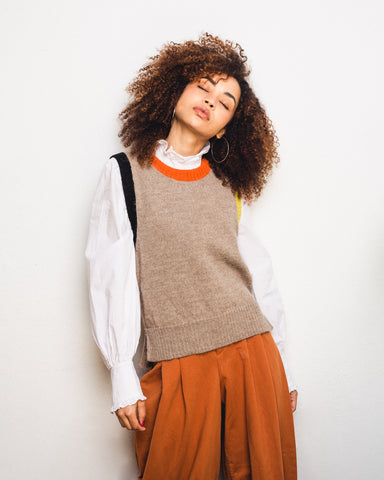How The Endery Uses Color to Fight Fast Fashion
Color theory is a natural element of design, but it takes on a life of its own when creating with waste. At The Endery, using only deadstock yarns has challenged us to push boundaries and embrace new, unruly color combinations. We’ve come a long way since our initial deadstock designs, but each knit is still an adventure that expands how we think about color and its role in our wardrobes and society.
Coloring Outside The Lines
A conventional garment design process lets the designer control colors and quantities. Working with deadstock, we have no control over how much is available in each color. What happens if a color runs out? How can we group colors in a way that feels relevant?
We had to create a flexible and responsive in-house color system. We’ve found inspiration in Josef Albers’ moving take on color theory, and artists such as Kusama, Haring and Basquiat who are known for defying the rules with their bold and unique approach to color.
After some trial and error, we landed on two solutions:
- Organizing the colors into unique color palettes
- Grouping together colors in a way that breaks up neutral and soft color palettes with pops of bold color, while making sure we're using up the small amounts of bright colors in the most efficient way possible
This allowed us to gather the available colors and launch the design process based on the color combinations we created.
Color As An Antidote To Fast Fashion
Taking a leap with color in our knitwear was so much more than an artistic risk. It was an assumption that consumers would be willing to embrace inconsistency. Fast fashion and conventional garment production processes require consistency, and we were challenging that in a big way. To fail would mean that we’d created clothes that people didn’t want to wear, which would contradict the purpose of The Endery.
There was only one way to test our hypothesis.
A Case Study In Color Rebellion
Faced with scraps of yarn in every color imaginable, our approach is built around color being fluid and ever-changing. Here are some of our favorite color studies from recent collections.
For our first ever alpaca wool knitwear release in FW19, the pinwheel pattern in The Pinwheel Crew was developed so that colors could easily be swapped in and out.

Stripes are a great way to use up lots of leftovers. We used as many as we could in our first Pima cotton collection for SS20 with The Edie.

Using all the ends is what inspired our brand name, and it’s something we take great pride in doing well. We also love primary colors. All of this came together perfectly in our Remainder Sweater Vest (FW20), with bright pops of ribbing made from remaining bits of yarn.

Lilac and red make a very unlikely pair, but that’s what we used in The Purple Watch. Released with our SS21 collection, it’s our best-selling sweater to date!

Black and yellow is always a hit when you want to make a bold statement. They do just that in the Leftover Bliss Cardigan in Gloriosa, part of our SS21 collection.

We were lucky to find periwinkle blue Pima cotton yarns for the Poppy Away Knitted Vest. The cool blue felt perfect for the hottest days of summer for our SS21 collection.

You Have The Power To Color Your World
Every color tells a story. As we brought unruly colors together, we had faith that people would appreciate the wild story they told—that they would want to wear our knits because they dig the idea and the conversations it led to. It turns out that we were right, but there was more.
Colorful deadstock knits lead to deadstock mending kits. A craft and color rebellion has grown out of our little deadstock vision thanks to everyone who believed in letting the narrative of leftover colors be told. Collaborations continue to take the story further. Together, we continue to challenge fast fashion and broken systems as we color our world.
Download our free Manifesto for more color-positive affirmations.





